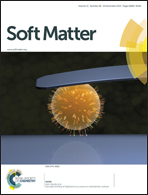Bimodality and re-entrant behaviour in the hierarchical self-assembly of polymeric nanoparticles†
Abstract
We show that a film of a suspension of polymer grafted nanoparticles on a liquid substrate can be employed to create two-dimensional nanostructures with a remarkable variation in the pattern length scales. The presented experiments also reveal the emergence of concentration-dependent bimodal patterns as well as re-entrant behaviour that involves length scales due to dewetting and compositional instabilities. The experimental observations are explained through a gradient dynamics model consisting of coupled evolution equations for the height of the suspension film and the concentration of polymer. Using a Flory–Huggins free energy functional for the polymer solution, we show in a linear stability analysis that the thin film undergoes dewetting and/or compositional instabilities depending on the concentration of the polymer in the solution. We argue that the formation via ‘hierarchical self-assembly’ of various functional nanostructures observed in different systems can be explained as resulting from such an interplay of instabilities.


 Please wait while we load your content...
Please wait while we load your content...